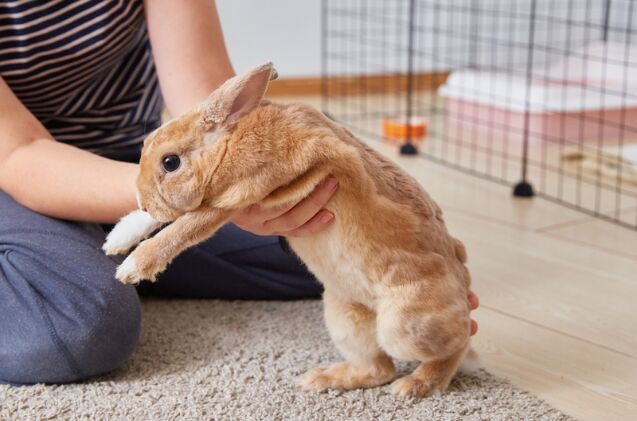Can I Make a Homemade Rabbit Cage?

Whether you are planning to bring home your first rabbit or changing things up with a new habitat for your bunny, choosing, planning out, and designing a cage can be a fun experience. But it can also be a costly one… One way to give your rabbit the best possible habitat without breaking the bank is to take on a rabbit cage DIY project – making alterations to a store-bought cage or building one yourself from scratch.
To help you get started, I have compiled a basic guide to setting up your own homemade rabbit cage, including some basic rabbit habitat information, a few commonly asked questions about a rabbit’s ideal environment, and step-by-step instructions to build your own DIY rabbit cage.
Can Rabbits Be Kept Without a Cage?
One of the first supplies most people purchase before bringing home a rabbit is a cage, but is a traditional cage necessary? As rabbit lovers and experts have learned more about the basic needs of their furry friends, new approaches to raising a rabbit have emerged. In fact, most of the standard rabbit cages you will see in your local pet stores are too small to provide the space needed for a happy, healthy life.
Free roaming refers to giving your rabbit access to your home or apartment so they can wander freely, even if you aren’t present. This is similar to how most people raise a dog or cat.
One way to do this effectively while still maintaining a clean and sanitary home is by litter training your rabbit. Just like cats, rabbits can be trained to do their business in a designated box or area. This keeps the mess contained, making it easier to clean up. But, of course, it requires putting the work into training and being prepared to deal with any accidents that may occur during that process.
Additionally, you must consider rabbit-proofing your home to prevent unwanted or potentially dangerous bad habits like chewing on your furniture or, even worse, chewing electrical cords.
This all takes time, money, and patience. If you aren’t prepared to take on this level of commitment to maintaining a safe, free-roaming environment, it is in the best interest of everyone involved (including you and your rabbit) to keep your rabbit safely contained in a suitable cage or pen.
Can Rabbits Live in a Playpen?
If you aren’t quite ready to allow your rabbit to roam freely in your home but still want to provide them with more freedom than a traditional cage, a playpen or exercise pen is a great alternative. These pens are often modular in design, meaning that you can set them up to suit your available space. While some are designed to have a top, others are open to the top, providing easier access to your rabbit. But you need to be aware of the height of the pen to ensure that your rabbit can’t jump out and escape.
Regarding setting up your rabbit’s playpen, it is best to consider the space the same way you would a cage. This means having a designated bathroom area with a litterbox (if you are using one), a space for your rabbit to sleep, and a separate area for food and water (including space for roughage like hay).
What Can I Use as a Rabbit Cage?
While we are on the topic of rabbit cage alternatives, there are other options outside of a playpen or homemade rabbit cage. These store-bought options will keep your bunny safely contained while providing the space they need.
Here are a few rabbit cage ideas for you to consider:
- Extra-Large Dog Crate: While most dog crates will be too small for a long-term enclosure, extra-large dog crates designed to meet the sizing needs of giant breeds may be large enough for smaller rabbit breeds. Pay attention to the construction of the bottom of the crate. Wire bottom crates introduce a risk of injury from having your rabbit's foot or leg slip through the hole and get stuck. However, many dog crates are outfitted with solid plastic or metal trays at the bottom, eliminating this problem.
- Designated Rabbit Room: If free-roaming the house is too much work, why not consider assigning one room in your home to be a designated rabbit room? This could be a spare room used solely for the rabbit, keeping the door closed to contain your rabbit when you aren’t around. Alternatively, you could block off a common area in your home or a portion of a common area (like the living room or den) using safety gates or fencing. Focus your rabbit-proofing efforts on the area of the home your rabbit has access to.
- Converted Large Storage Containers: Some rabbit parents create large, comfortable rabbit enclosures using plastic storage containers. To do this, you will need to search for a container that is large enough to meet the basic space requirements for a rabbit (at least 12 square feet of enclosure space). Cut plenty of holes in the sides of the container to offer airflow, but be careful not to make those holes large enough for your rabbit to escape. If you can’t find a large enough container, you may be able to combine two if they can move easily between them.
- Outdoor Rabbit Hutch: Some rabbit parents are now returning to the traditional rabbit hutch, originally used for rabbits raised for farming purposes. These structures are designed to safely contain your rabbit outdoors, offering shelter from the elements. If you live in an area that sees cold winters, you will need to ensure the hutch has proper insulation or that there is a separate indoor space where your rabbit can be kept during the winter months. Your outdoor hutch must also be reinforced to offer protection against local predators.
Is it Cheaper to Build a Rabbit Cage or Buy One?
The short answer is: It depends! That’s right, there is no black-and-white answer to the question of pricing related to a store-bought rabbit enclosure versus a homemade rabbit cage. You can create homemade rabbit cages that are highly budget-friendly, or they can be large, elaborate, and far more costly.
If a tight budget is driving your decision, I recommend exploring your options. Search for store-bought pens or enclosures that may be on sale to keep costs down. If you are set on building your own rabbit cage, you must make intentional build decisions with your budget in mind. Keep in mind that many of the options we have introduced may be available at a significantly reduced cost on Facebook marketplace or at local garage sales.
My first rabbit as a child, Cutie, had a cage built out of an extra-large dog crate purchased for pennies at a garage sale. You just have to keep your eyes open!
How to Build a Rabbit Cage: Step-by-Step
After reading the above information, are you still inspired by the creative homemade indoor rabbit cages you see on social media? If so, here are the basic steps to build a homemade rabbit cage that will meet all your furry friend’s needs:
Step One: Gather Your Materials
You will need to consider what materials you will use to build out your rabbit’s enclosure. There are a few standard options. One is to build a wooden frame and attach wire on the sides and top, creating an enclosure that resembles a traditional hutch. But I have also seen a growing number of rabbit lovers using wire storage cubes to create a modular rabbit cage or pen nearly identical to the store-bought varieties. If you are using storage cubes, you will also need zip ties to secure the connection points.
Step Two: Design Your Pen’s Shape and Size
The biggest perk to building your own rabbit cage is that you can easily adapt it to suit your available space. For example, if you have a large, narrow area at one end of your bedroom, you can leverage the length to provide more room for your rabbit to move. Don’t be afraid to be creative, like creating an L-shaped enclosure to make the most of a corner space.
Step Three: Assemble the Storage Cubes
Using the connectors provided with your storage cube step, assemble the panels to match your design. Depending on the size of the storage cubes you purchased, one panel may be tall enough to keep your rabbit contained, or you may have to build it out two panels high. Reinforce each connection point using your zip ties, cutting off any excess material to prevent your rabbit from chewing on and potentially ingesting it.
When setting this up, you will need to consider the placement of a door (or two) or the alternative of lifting your rabbit up and over the side of the pen. If you are assembling your pen with a door, only attach zip ties on one side of that panel so that it can open and close. You can secure doors using small metal carabiners.
Step Four: Consider the Base
You want to ensure that your rabbit is comfortable on the floor or surface of their pen. If you’re setting your pen up on a hardwood floor or other hard, slippery surface, you may want to add a mat, carpet, or yoga mat on the bottom. Not only will this make the area more comfortable for your rabbit, but it will also protect your floor from damage. For added protection, consider placing puppy pee pads under any mats that aren’t waterproof.
Step Five: Decorate and Accessorize
Now that you have the basic structure, it’s time to build out your rabbit’s enclosure in a way that will both suit your personality and provide for all their basic needs. Some essential elements you may want to consider include food dishes, a hay rack, a water bottle, and a litter box. Don’t forget to offer toys or interactive elements to provide the mental enrichment necessary for a happy, healthy life.
Final Thoughts: Building a Rabbit Cage
One of the most important decisions you can make for your rabbit’s health and happiness is to provide them with a habitat that will provide for all their needs. Many great store-bought options are available, but these can come with a higher price tag. Additionally, they are somewhat limited in their structure and design, which may not make the most of your available space. For this reason, there is a growing number of rabbit lovers who are choosing instead to design and build a homemade rabbit cage or homemade rabbit hutch.
When planning your rabbit’s cage, ensure that you include all necessary elements like a hay box, sleeping area, room to move freely, and toys or other enrichment opportunities. If the enclosure is smaller (but still meets the recommended minimum space requirements), you may also want to consider setting up a secondary exercise area in the home or allowing free roaming when your rabbit is supervised to allow for needed physical activity.
Caring for a rabbit does require work, planning, and preparation. But it will all be worth it when you bring your new furry family member home and begin the process of building that special bond that we all know and love!

Britt Kascjak is a proud pet mom, sharing her heart (and her home) with her “pack” which includes her husband John, their 2 dogs – Lucifer and Willow – and their 2 cats – Pippen and Jinx. She has been active in the animal rescue community for over 15 years, volunteering, fostering and advocating for organizations across Canada and the US. In her free time, she enjoys traveling around the country camping, hiking, and canoeing with her pets.
More by Britt
























